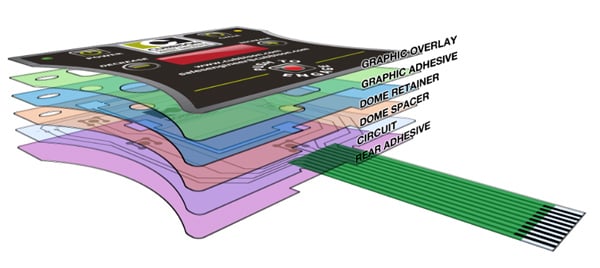Why Membrane Switches Are Necessary for Sturdy Control Systems
Membrane buttons play a crucial duty in making sure the longevity and dependability of control systems across numerous sectors. As we explore the complex benefits of membrane layer buttons, it comes to be obvious that their importance goes beyond mere performance, influencing user experience and operational effectiveness.
Summary of Membrane Buttons
Membrane switches are functional and reputable parts commonly made use of in different electronic control systems. These switches consist of numerous layers, including a graphic overlay, a spacer layer, and a printed circuit layer. The visuals overlay gives both practical and visual style, while the spacer layer guarantees that the buttons are triggered just when pushed. The printed circuit layer contains conductive traces that finish an electrical circuit when the membrane is pushed, making it possible for the gadget to reply to customer inputs.
Membrane layer switches are frequently favored in applications needing a small and lightweight design, making them suitable for portable gadgets, clinical devices, and industrial machinery. They can be tailored to meet details customer needs and can include different functions such as backlighting, tactile feedback, and numerous shades. Membrane switches are immune to dirt, dampness, and pollutants, making them appropriate for environments where durability is important.
Benefits of Durability
In lots of applications, the toughness of membrane switches over deals substantial advantages that boost their overall performance and reliability. These buttons are designed to endure severe settings, making them excellent for use sought after conditions such as high humidity, extreme temperatures, and exposure to chemicals. Their robust building assists to stop damage from physical impact, ensuring long-lasting performance and minimizing the demand for frequent substitutes.
In addition, membrane layer switches are resistant to wear and tear, which is vital in applications where frequent communication takes place. This sturdiness equates to lower maintenance costs, as companies profit from reduced downtime and fewer solution interruptions. The encapsulated design of membrane switches shields interior components from dust and moisture ingress, additional contributing to their life-span (membrane switch).
An additional benefit is their capacity to maintain consistent performance with time. With a high resistance for mechanical stress, these switches maintain their tactile responses and electrical stability, making sure user contentment. Ultimately, the resilience of membrane layer switches not only boosts operational efficiency yet likewise fosters confidence in their dependability, making them a recommended choice for control systems throughout different sectors.
Applications in Various Industries
Resilient control systems using membrane layer switches discover substantial applications across a series of sectors, each taking advantage of the special features these buttons use. In the clinical field, membrane switches are vital for gadgets such as individual screens and analysis tools, where reliability and simplicity of cleaning are paramount. Their resistance to wetness and contaminants ensures they preserve performance in sterilized atmospheres.
The automotive industry leverages membrane layer buttons for dashboard controls and infomercial check systems, where they provide sleek, inconspicuous user interfaces that boost individual experience. These buttons are additionally designed to stand up to extreme conditions, including direct exposure to extreme temperature levels and vibrations.
In industrial setups, membrane layer switches are generally utilized in machinery control board, using responsive comments and sturdiness necessary for high-usage applications. Their capability to withstand chemicals makes them ideal for producing atmospheres where spills and contaminants are regular.

Consumer electronic devices, such as cooking area appliances and remote controls, likewise utilize membrane layer switches for their adaptability and cost-effectiveness. In general, the versatility and robust nature of membrane layer switches make them vital across various sectors, making certain reliable operation and longevity in control systems.
Design and Aesthetic Allure
While performance is extremely important, the design and aesthetic allure of control systems outfitted with membrane layer buttons play an important duty in customer involvement and total experience (membrane switch). The aesthetic style of these switches can substantially affect user assumption and interaction. A well-designed membrane button boosts the good looks of the device, making it much more appealing to users and cultivating a connection in between the user and the product
Membrane layer changes supply a large amount of versatility in style, permitting makers to tailor graphics, colors, and appearances to line up with brand identity and product aesthetic appeals. Using vibrant shades and distinctive patterns can draw focus, while responsive comments can strengthen the customer's interaction with the device. In addition, the ability to incorporate LED indications and backlighting right into the membrane button design provides both practical and aesthetic benefits, improving exposure and usability in numerous settings.

Enhancing User Experience

Furthermore, membrane buttons can be tailored to incorporate graphical user interfaces, boosting functionality by providing information in a clear and intuitive way (membrane switch). This personalization can include icons, labels, and shade coding that guide customers with facility functionalities effortlessly. Furthermore, their flexibility enables for combination in various settings, guaranteeing consistent performance whether in commercial machinery or customer electronics
The sturdiness of membrane layer buttons also plays a crucial role in individual experience. By withstanding harsh conditions and expanded usage, these buttons decrease the probability of system failings, thus promoting integrity and user self-confidence. Eventually, the critical usage of membrane layer switches over not just elevates functionality but also significantly improves customer communication with control systems, making them an essential part in modern-day layout.
Final Thought
